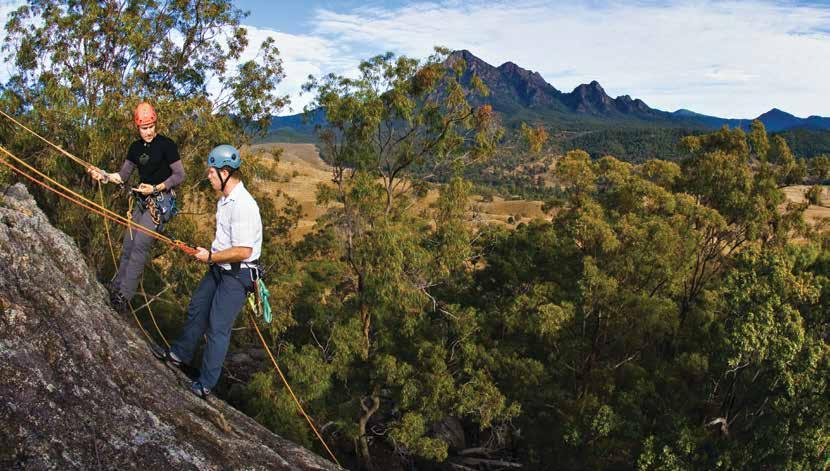
4 minute read
MAJOR DRIVERS OF THREATS TO BIODIVERSITY
Three key regional drivers of change in the extent and condition of natural assets over the last decade which will continue to influence society, economy and the environment of the Scenic Rim are:
1. Demographic changes including population growth and migration with associated infrastructure and intensification 2. Land use changes (particularly the scale of development) with associated vegetation clearing 3. Changing climatic conditions including extreme weather events
POPULATION GROWTH AND DEVELOPMENT
The population of the Scenic Rim is estimated to grow to 81,985 people by 2036 (Queensland Government, 2015). Regional centres including Beaudesert, Tamborine Mountain and Boonah require increasingly larger amounts of land to accommodate new residents. Industrial areas including the Bromelton State Development Area will also have profound impacts on biodiversity in the region.
LAND USE CHANGE
Habitat loss and fragmentation often associated with agriculture and land use change are two priority concerns for biodiversity. As vegetation patches are reduced in size they become isolated and the on-going viability of plants and animals is severely affected. This ultimately leads to a reduction in species migration, dispersal, recycling of nutrients, pollination of plants and other natural functions required for ecosystem, social and economic health.
Loss of soil is also a consequence of inappropriate land use and vegetation management which can threaten the economic viability of many enterprises. Based on known plans for development and other land use change, it is estimated, there is potential for 3,322ha of bushland to be affected by 2031 (SEQ NRM Plan 2014 Update).This is below the bushland cover target of a minimum of 30% for the Scenic Rim.
CHANGING CLIMATE
Changes in climatic conditions may be placing increased pressure on biodiversity, society and the economy. Pressures including extreme weather events including flooding events in 2011 and 2013 and the Millennium Drought (2001-2009) as well as heat waves have the ability to alter the range and abundance of many plants and animals.
The impacts of a changing climate are likely to result in changes in species distribution and abundance. While some species will adapt and even thrive in new conditions, other species will be susceptible to reduced range and local extinction.
PEST PLANTS AND ANIMALS
Invasive weeds have the potential to outcompete native flora reducing biodiversity within the region. This in turn places pressure on native fauna reliant on food
sources and habitat. Invasive pest animals can often out-compete native animals for resources and habitat.
Introduced pests place increased pressure on natural systems including predation on native fauna, competition with native animals and damage to habitat. Pest animals have the ability to extinguish entire species through predation, disturbance of habitat and removal of food sources. Many pest and weed species have naturalised throughout the region creating significant challenges for management.
Pest plants and animals also impact upon agricultural production. Currently legislative focus has aimed at the impact of these pests on agricultural business but not biodiversity. Pest plant and animal management requires an integrated approach to enable cost effective outcomes which support biodiversity.
LAND MANAGEMENT AND AGRICULTURAL PRACTICES
Unsustainable agricultural and land use practices pose a threat to the biodiversity of the Scenic Rim Region. Increased soil erosion, water quality decline, salinity and habitat fragmentation all pose threats for retaining biodiversity within the region. These issues also impact on the economy especially agriculture as well as infrastructure including roads, bridges and water storages.
A whole of landscape approach involving all land managers is required to ensure biodiversity and farm productivity is maintained and the flow on benefits can be received right across the community and the economy. In particular, this requires appropriate management of National Parks and engagement of peri-urban or rural residential land managers in natural asset management.
Peri-urban land use change and urban development

represents specific issues for land use planners and natural asset management. Increasing numbers of smaller lots can complicate whole of landscape approaches to natural asset management.
FIRE MANAGEMENT
Maintaining an appropriate fire regime is important for the maintenance of biodiversity. In many cases, fire frequency and intensity can result in reduced biodiversity, weed invasion and habitat destruction. Different ecosystems require different fire management regimes to maintain biodiversity. Areas such as rainforests require total fire exclusion in contrast to certain dry eucalypt forests that require periodic burning to reduce fuel loads and initiate obligate seeder species. Mismanagement of controlled burns, fire planning and management can result in reduced biodiversity and increased safety risk to landholders.
SALINITY
Strategic vegetation management forms part of the integrated approach for addressing salinity. The Purga, Teviot and Upper and Mid Warrill sub catchment are at risk from salinity. There are currently 25 subcatchments in the Scenic Rim affected by dryland salinity. The major extents include Purga Creek sub catchment (220 ha) and Warrill Creek sub catchment (205 ha).
Focusing vegetation management in these subcatchments will enhance biodiversity while decreasing the risk of salinity damage to agricultural land and waterways. A Salinity Management Plan is available for Roadvale in the Purga Creek sub catchment.







